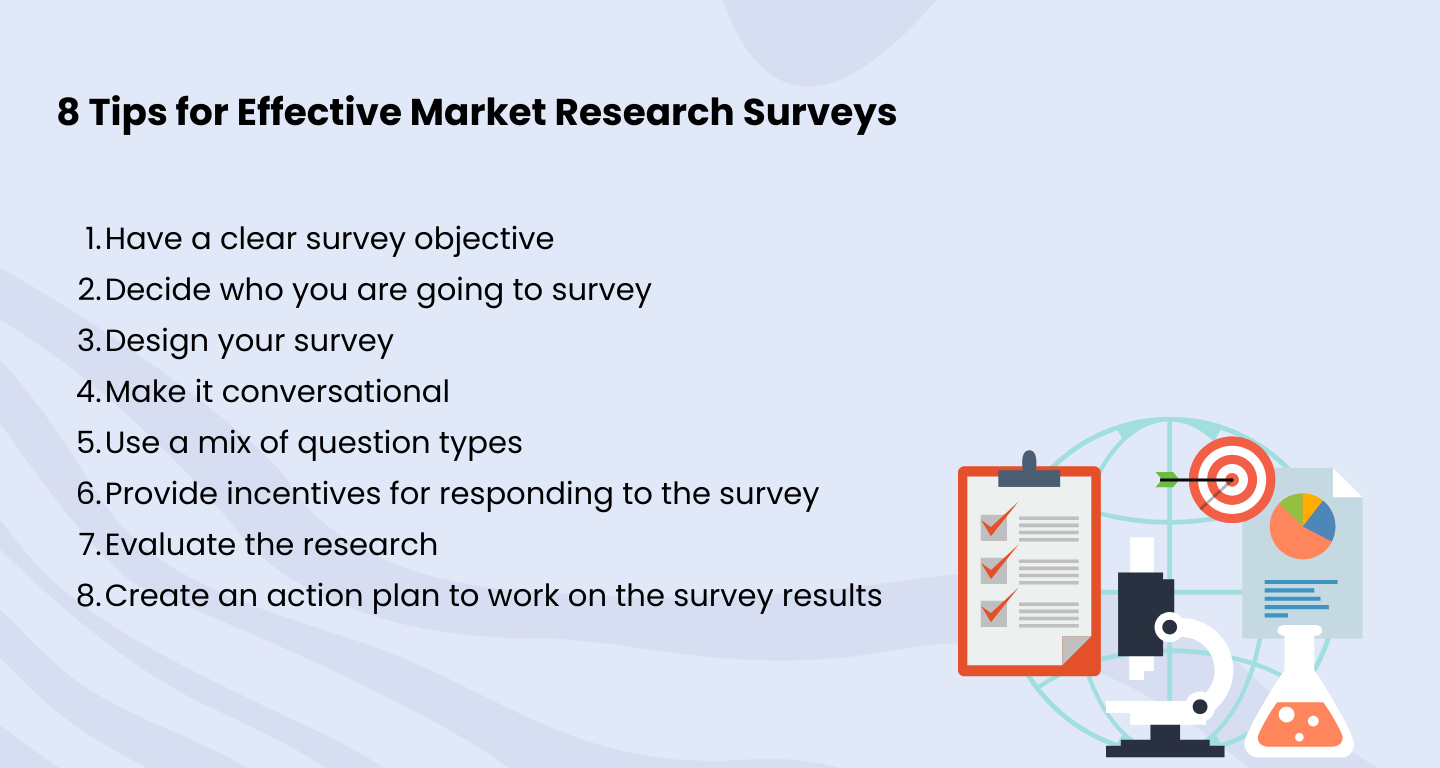Survey & Feedback
The Beginner's Guide to Market Research Surveys
Article written by Kate William
Content Marketer at SurveySparrow
13 min read
19 September 2025

Launching a product or service without conducting market research surveys can be an expensive mistake.
It’s not just about having the right product; it must also launch at the right time in the right location to reach its target audience. Just imagine Mark Zuckerberg writing an iconic book, “How to Become a Tech Billionaire” – targeting entry-level engineers.
Despite plenty of real-life cautionary tales, global spending on market research still topped 82.62 billion USD in 2022. These numbers show how important these surveys are for businesses worldwide.
In this blog, we will:
- Define a market research survey
- Explore 12 types of market surveys
- Understand the objectives of market research
- List 8 tips on how to do market research surveys
What is a Market Research Survey?
Market research surveys are an important tool used to gain insight into a product, service, or concept. Companies use market research surveys to get a better understanding of what their customers want and need.
Through marketing survey questions, they can assess the current demand in the market, and measure customer satisfaction with existing products and services.
Moreover, market surveys are also used to understand customer buying behavior and analyze the effectiveness of advertisements.
12 Types of Market Research
|
Type of Market Research |
Research Methodology |
| Primary Research | Direct interviews and surveys |
| Secondary Research | Data from existing sources |
| Qualitative Research | Feelings, opinions, and insights |
| Quantitative Research | Numerical data via surveys |
| Target Research | Specific customer segments |
| Consumer Research | Understanding consumer needs |
| Medical Research | Healthcare professionals and patients |
| Product Research | New product/service insights |
| Value Research | Perceived product/service value |
| B2B Research | Business behavior and preferences |
| Free Research | No payment, free tools |
| Paid Research | Compensation for participation |
1. Primary Market Research
Primary market research is data collected directly from interviews and surveys with customers, stakeholders, and other relevant parties. This type of research helps companies make informed decisions about their products/ services.
2. Secondary Market Research
Secondary market research is a type of research that collects data from existing sources – such as government agencies, trade associations, or other organizations. This can be used to gain insights into an industry or customer base, and help businesses make informed decisions about their strategies and operations.
3. Qualitative Market Research
Qualitative market research uses non-quantifiable data such as feelings and opinions to gain insights into consumer attitudes, beliefs and motivations. This type of research is often used to identify unmet needs or new areas of opportunity for products and services.
4. Quantitative Market Research
Quantitative market research collects numerical data through surveys. It measures customer opinion to gain insights into customer behavior. This type of market research helps companies make informed decisions based on statistical analysis.
5. Target Market Research
Target market research aims to identify and understand specific customer segments. It helps companies develop marketing strategies that are tailored to the needs and preferences of their target audience.
6. Consumer Market Research
Consumer market research is a type of research that focuses on understanding the wants and needs of consumers. It helps companies make informed decisions regarding product design, pricing, positioning, and promotion strategies.
7. Medical Market Research
Medical market research is a type of market research that focuses on understanding the needs and preferences of healthcare professionals and patients. This helps healthcare professionals learn how to improve their services, and reach and retain more patients.
8. Product Market Research
Product market research is a type of market research that focuses on understanding the wants and needs of potential customers for a new product or service. It helps companies make decisions about product design, positioning, pricing, and promotion strategies to maximize its success.
9. Value Market Research
Value market research is a type of market research that focuses on understanding the perceived value of a product or service. It helps companies understand how much customers are willing to pay for a particular product or service, and also how their competitors’ offerings compare.
10. B2B Market Research
B2B market research is specifically focused on understanding the behaviors and preferences of businesses that purchase other businesses’ products or services. It gives insights on the customers, competitors, opportunities, and risks in a given industry.
11. Free Market Research
Free market research is a type of market research that does not require any form of payment. It uses free market research tools and can be conducted by businesses or individuals.
12. Paid Market Research
Paid market research is a type of market research that requires some form of payment, usually in the form of compensation or recognition. Participants are paid to take part in the study – which can include filling our surveys, research studies, online panel, etc.
To simplify your market research and gather valuable insights seamlessly, consider using a user-friendly platform such as SurveySparrow. You can engage your target audience, collect data and make informed decisions with ease. Try it out for free!
14-day free trial • Cancel Anytime • No Credit Card Required • No Strings Attached
What Are The Main Objectives of Market Research Surveys?
Business market research is a powerful tool – no matter what type of business you are in. Here’s what it aims to help you with:
- Learn about your customers, their expectations from you, and what your competitors do to keep ahead of you – or what they lack when compared with you.
- Discover new opportunities for your company.
- Survive if you are going through a bad phase. This because market research data can help you with strategic direction-setting.
- Identify potential risks when you’re preparing to launch a product or service.
- Understand your customer’s opinion, and take actionable steps toward a more positive perception.
- Project sales and plan ahead to help maximize profits.
- Predict trends in your niche and stay ahead of competitors.
- Track the performance of your new product or service – straight from the customer.
- Get unbiased, unfiltered feedback to establish an effective positioning strategy.
For a powerful edge in your product’s launch, consider arming yourself with the power of online marketing research. Here’s how to access valuable insights for success using an easy-to-follow framework.
8 Tips for Effective Market Research Surveys
Here are some best practices that are essential for gathering essential and valuable insights:

1. Have a clear survey objective
When launching your market research survey, it’s crucial that you have a strong idea of what success looks like. What is the desired outcome?
As an example, here is an outcome: “Know how much customers are willing to pay for my product.” Also, are customers more likely to opt for one-time purchases or subscriptions?
Knowing your end goal is essential in helping determine which market research tools and techniques will provide insight most efficiently. So collaborate with colleagues to zero in on 2-3 key objectives!
2. Decide who you are going to survey
Targeting your ideal customer is essential for success. To ensure you make the best use of resources, be specific about who it is that you are trying to reach – by collecting demographic data such as age, location and occupation. This will involve different types of initial market surveys, from primary to secondary market research.
This will help eliminate irrelevant respondents from different regions. If selling a product in North America, then those living in MENA need not apply!
Having an email list or having previously conducted surveys also means there’s already valuable data on-hand. This might just provide insight into what potential customers may look like.
3. Design your survey
When you know who to target, the next step is to design your survey in a way that is appealing and will elicit responses.
Carefully consider which kind of market research questions to ask, as well as the structure they should follow. Keeping the size of surveys to a minimum is also essential; less can often mean more in this context, inspiring better survey response rates.
If necessary, enlisting the help of market research software with ready-to-use templates can provide both structure and guidance. Make sure all relevant stakeholders review your questions before finalizing the survey and sending it out into the universe!
4. Make it conversational
It’s important to remember that successful businesses are built upon relationships, and this applies to customer interactions as well.
As you reach out to your customers, avoid being too transactional in your communications. Or else they may perceive you as only interested in taking from them, rather than forging a meaningful connection.
Using the right tone is key when engaging with customers. When writing emails and other communications with them, make sure it is conversational and natural – like how they would speak to family and friends.
Also include their names throughout any communication – this offers a sense of personalization that people appreciate. Is there something else you can do to show extra appreciation? If so, don’t hesitate to go the extra mile!

5. Use a mix of question types
Choosing the right scale to measure customer response requires careful consideration.
There are over 20 kinds of scales available, but they can be generally divided into two categories: comparative and non-comparative. Several popular scales include the Likert Scale, Graphic Rating Scale, Semantic Differential Scale and Side-by-Side Matrix.
It’s important to use multiple scales in surveys to get a wider range of feedback from respondents – rather than arbitrary choices made using just one scale. More perspectives help you conduct better analysis and make informed decisions based on collected data.
6. Provide incentives for responding to the survey
Ensuring you get the right responses to your surveys doesn’t have to be a daunting task.
Former customers may already be familiar with your product, so they can provide valuable insights. To encourage participation in your survey, provide incentives such as e-books, gift cards and expert advice.
Incentives give people an additional motivation to complete surveys, increasing the chance of meaningful feedback.

If crafted skilfully, a concise message can prompt even a novice to take your survey. Utilize an easy-to-click CTA button to guide your customer through.
Additionally, the subject line should be attention-grabbing and pique their interest. Applying these strategies will improve the rate of responses from potential customers.
Read more: 7 Tips To Enhance Your Survey Response Rate
7. Evaluate the research
Upon collecting data, it should be analyzed and organized in different formats such as charts, graphs, and tables. Doing so allows one to better interpret the information.
Various visual analytics tools like Tableau can help with this process. Additionally, analyzing the most common words used in text is another helpful technique.
To further strengthen your results, consider calling those who have filled out the survey. This approach will expose invaluable insight on what changes need to be made to optimize product usage.
Upon completing these steps, spreadsheets should be printed out for further studying. Furthermore, online market research surveys allow users to view preliminary results while the survey is still ongoing; this helps refine survey processes tremendously.
8. Create an action plan to work on the survey results
The survey results serve as a guide for structuring corporate actions and decision-making. Refer to your initial objectives, then develop actionable statements based on the survey data.
Increase user onboarding optimization, email sign-ups, and discovery call bookings incrementally – avoid making major alterations quickly or abruptly.
With proper implementation, these changes can lead to positive results in multiple areas of your business.
Wrapping Up
Conducting market research surveys does not have to be an expensive process. There are a variety of tools like SurveySparrow that can help with the entirety of the market research survey; from data collection and analysis to result compilation.
The reward for this process is getting a direct, first-hand account from customers about their expectations from your business.
Use different kinds of market research survey to not lose sight of the broader purpose at hand. Making sure you regularly contact customers for their opinion and do something constructive with it is indicative of a business pushing forward towards success.
14-day free trial • Cancel Anytime • No Credit Card Required • No Strings Attached

Create engaging surveys that people actually complete. Try SurveySparrow now!
Kate William
Related Articles

Survey & Feedback
How to Embed Google Forms in Website
10 MINUTES
26 August 2022

Survey & Feedback
110+ Post Training Survey Questions to Ask in 2025
12 MINUTES
5 April 2022

Survey & Feedback
The Beginner's Guide to Market Research Surveys
13 MINUTES
29 May 2018

Survey & Feedback
Online Surveys for Money: Top Platforms, Tips & Strategies
7 MINUTES
10 July 2024
